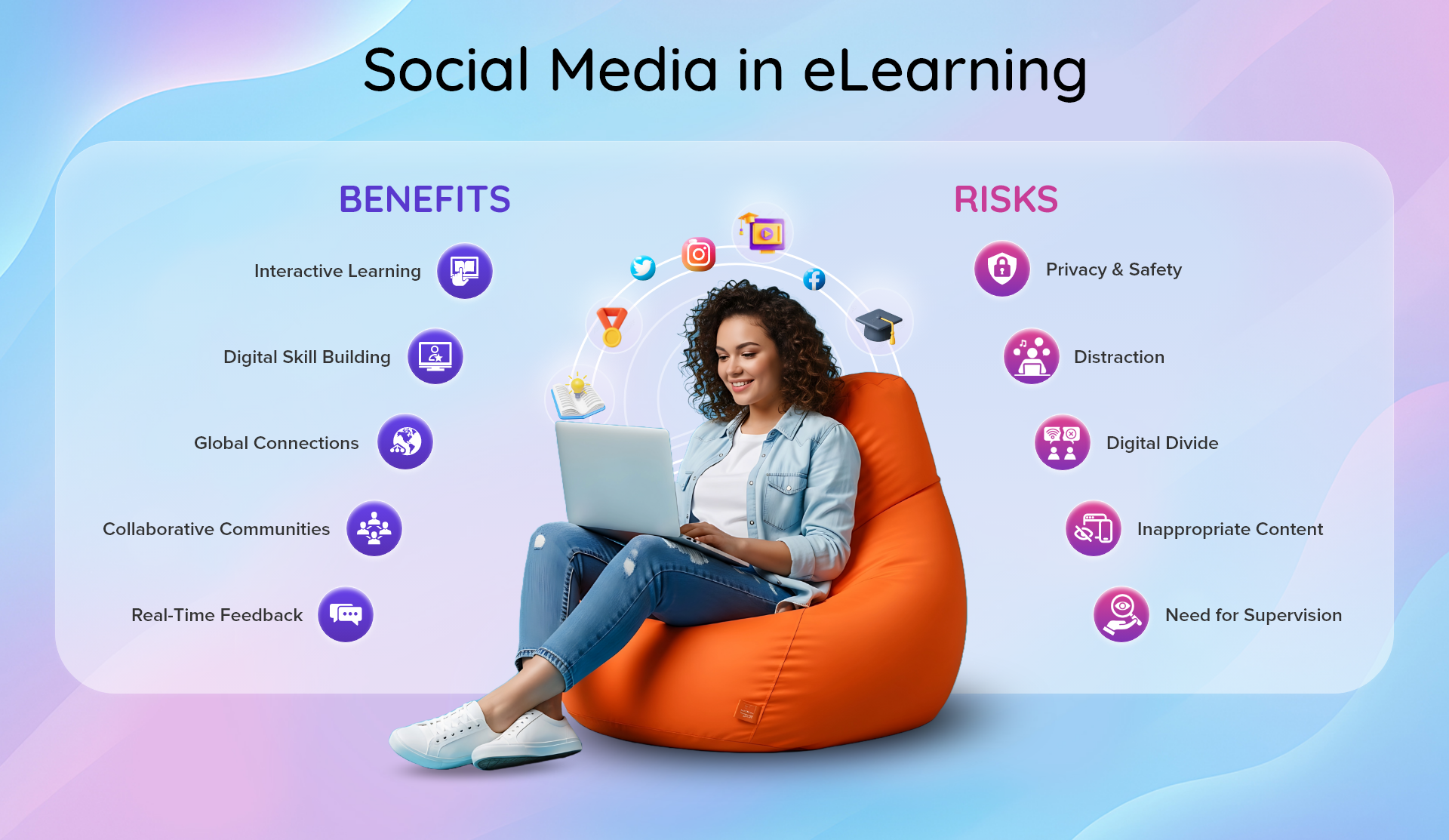The blog emphasizes how social media can transform eLearning by fostering real-time collaboration, building digital skills, and breaking down communication barriers across teams. However, it also warns of potential challenges like privacy concerns, distractions, and unequal access—highlighting the need for thoughtful integration, moderation, and clear governance to harness its full potential effectively.
Not long ago, social media was seen as a distraction in the workplace. Today, it’s becoming an essential tool for professional development and corporate learning. From LinkedIn learning groups to micro-learning on YouTube or collaborative project spaces on Slack and WhatsApp, social platforms are reshaping how organizations deliver training and engage employees.
Social media in eLearning offers exciting opportunities—but it also brings challenges that learning leaders must carefully navigate.
The Bright Side of Social Media in eLearning
Social media platforms offer unique ways to make eLearning more engaging and relevant for today’s learners. When used thoughtfully, these tools can transform how learners interact with content.
1. Making Learning Engaging and Interactive
Employees are already comfortable using social platforms. Integrating them into training allows learners to collaborate, ask questions, and share insights in real time. For example, private LinkedIn groups or Teams channels can host ongoing discussions, while YouTube-style micro-videos can turn complex policies into digestible, engaging lessons.

2. Building Essential Digital Skills
Modern careers demand strong digital communication skills. By incorporating social media into eLearning, employees learn how to create, share, and interact with professional content, improving both technical fluency and digital etiquette—skills that extend well beyond training modules.

3. Breaking Down Silos
Social media removes organizational and geographical barriers. A sales team in Singapore can exchange strategies with colleagues in the U.S., while remote workers can stay connected to ongoing learning communities. This fosters collaboration, knowledge sharing, and a stronger sense of belonging.
The Challenges We Can’t Ignore
1. Privacy and Security
When training conversations move to social platforms, sensitive company data or personal information can be exposed. Organizations must set clear policies, provide secure environments, and educate employees about compliance.
2. The Distraction Factor
Social tools are double-edged: while they support engagement, they can also divert attention. Blended approaches that integrate focused LMS content with social discussion can help balance productivity and interaction.
3. The Digital Divide in Organizations
Not every employee has equal access to reliable devices or high-speed internet. Overlooking this can create uneven learning opportunities and frustrate learners. Ensuring mobile-friendly and offline-capable options is essential.
4. Inappropriate or Off-Topic Content
Just as in public platforms, corporate social learning environments can suffer from irrelevant or unprofessional posts. Effective moderation and clear guidelines are critical to maintaining value.
Quick Reference: Benefits vs. Risks
| Benefits | Risks |
| Boosts engagement through real-time collaboration | Raises privacy and compliance concerns |
| Develops digital communication and content-sharing skills | Can create distractions and lower productivity |
| Connects dispersed teams and fosters knowledge exchange | Highlights access and connectivity inequalities |
| Encourages user-generated learning and peer support | May lead to irrelevant or inappropriate contributions |
| Provides ongoing discussion and feedback loops | Requires moderation and governance |
Finding the Right Balance
In eLearning, the question isn’t whether to use social media—it’s how to use it wisely. Clear governance, thoughtful integration, and a focus on digital responsibility are key.
For organizations, the payoff is huge: social media, when aligned with training goals, can turn static eLearning into a dynamic, collaborative, and continuous learning experience. It transforms training from a one-time event into an ongoing conversation—helping employees not just learn, but grow together.
Not long ago, social media was seen as a distraction in the workplace. Today, it’s becoming an essential tool for professional development and corporate learning. From LinkedIn learning groups to micro-learning on YouTube or collaborative project spaces on Slack and WhatsApp, social platforms are reshaping how organizations deliver training and engage employees.
Social media in eLearning offers exciting opportunities—but it also brings challenges that learning leaders must carefully navigate.
The Bright Side of Social Media in eLearning
Social media platforms offer unique ways to make eLearning more engaging and relevant for today’s learners. When used thoughtfully, these tools can transform how learners interact with content.
1. Making Learning Engaging and Interactive
Employees are already comfortable using social platforms. Integrating them into training allows learners to collaborate, ask questions, and share insights in real time. For example, private LinkedIn groups or Teams channels can host ongoing discussions, while YouTube-style micro-videos can turn complex policies into digestible, engaging lessons.

2. Building Essential Digital Skills
Modern careers demand strong digital communication skills. By incorporating social media into eLearning, employees learn how to create, share, and interact with professional content, improving both technical fluency and digital etiquette—skills that extend well beyond training modules.

3. Breaking Down Silos
Social media removes organizational and geographical barriers. A sales team in Singapore can exchange strategies with colleagues in the U.S., while remote workers can stay connected to ongoing learning communities. This fosters collaboration, knowledge sharing, and a stronger sense of belonging.
The Challenges We Can’t Ignore
1. Privacy and Security
When training conversations move to social platforms, sensitive company data or personal information can be exposed. Organizations must set clear policies, provide secure environments, and educate employees about compliance.
2. The Distraction Factor
Social tools are double-edged: while they support engagement, they can also divert attention. Blended approaches that integrate focused LMS content with social discussion can help balance productivity and interaction.
3. The Digital Divide in Organizations
Not every employee has equal access to reliable devices or high-speed internet. Overlooking this can create uneven learning opportunities and frustrate learners. Ensuring mobile-friendly and offline-capable options is essential.
4. Inappropriate or Off-Topic Content
Just as in public platforms, corporate social learning environments can suffer from irrelevant or unprofessional posts. Effective moderation and clear guidelines are critical to maintaining value.
Quick Reference: Benefits vs. Risks
| Benefits | Risks |
| Boosts engagement through real-time collaboration | Raises privacy and compliance concerns |
| Develops digital communication and content-sharing skills | Can create distractions and lower productivity |
| Connects dispersed teams and fosters knowledge exchange | Highlights access and connectivity inequalities |
| Encourages user-generated learning and peer support | May lead to irrelevant or inappropriate contributions |
| Provides ongoing discussion and feedback loops | Requires moderation and governance |
Finding the Right Balance
In eLearning, the question isn’t whether to use social media—it’s how to use it wisely. Clear governance, thoughtful integration, and a focus on digital responsibility are key.
For organizations, the payoff is huge: social media, when aligned with training goals, can turn static eLearning into a dynamic, collaborative, and continuous learning experience. It transforms training from a one-time event into an ongoing conversation—helping employees not just learn, but grow together.
You must be logged in to post a comment.
- Most Recent
- Most Relevant







